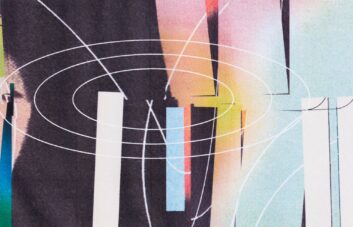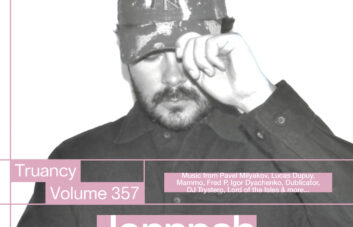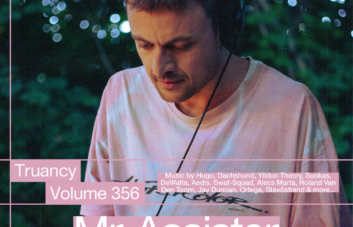GIL is the latest to join the ranks of Aïsha Devi’s Danse Noire imprint. Emerging from a background of contemporary dance and composition, the Berlin-based producer brings us the 8th offering from the inimitable label which has previously seen the likes of IVVVO and Vaghe Stelle all contribute. Orchids & Wasps gathers together GIL’s various influences in his journey thus far and comes complete with racing remixes from J.G Biberkopf and Imaabs. Focusing on the marriage of divergent styles, rhythms and emotions, each track leads perfectly onto the next. Convulsive and perpetuating, the compositions and their remixes ooze a breath of fresh air into this niche of electronica.
Orchids & Wasps covers a lot of ground and is quite the statement for a debut EP. The aesthetics fit Aïsha Devi’s Danse Noire perfectly – where did your relationship with Aïsha begin? “It all happened rather fast. I had seen Aïsha playing live once before and was very impressed. But I hadn’t met her personally until I played my first live set at the Les Urbaines festival which happens yearly in Lausanne, Switzerland. That was in December 2015 and Samuel, who is part of Danse Noire, was one of the musical curators for it at the time. He and the other three members of Danse Noire were watching my set at the festival – they came up to me after the show, said that they liked it a lot and asked me to send them a demo in case I ever meant to release the music I had performed. Things became very concrete within a month or two and we have become good friends and been working quite closely since then.”
To call Orchids & Wasps an EP is somewhat understating. It’s often the case for an EP to have a common denominator holding it all together, but here each track seems to tell a whole story in itself. Was it important to have an essence of prose when composing each track? “It wasn’t something I had in mind specifically. But I feel like with longer compositions, especially when they don’t conform to more conventional song structures, a certain element of prose will always be discernible – albeit sometimes it can be developed solely in the listener’s experience. As in when you listen to a piece composed completely at random, for example by John Cage, and start hearing and recognizing a sense of continuity or coherence.
“I wrote most of what would then become Orchids & Wasps for the live set I mentioned above. So mainly with that in mind I did want to work on longer dramaturgies than the usual 4 minutes and wanted the tracks to develop in a rather free-form way. Playing with the non-/fulfilment of the listeners’ expectations was essential and for me non-/structure is one of the best ways to do so. So I let the material and motives develop into different directions and appear in different ways, which I think results more or less inevitably in something rather prosaic.”
I love the juxtapositions in your tracks. “Many” in particular seems to marry chaos and joviality – two very disparate ideas. This also permeates the other tracks in some form or another. Were the samples a starting point when composing the EP or did they find their way in after the chaos ensued? “They definitely were a starting point for each track. I wanted to use both familiar sounds, like the often-used scream sample in “Onset”, and sounds the familiarity of which I would establish myself, like with this almost anthemic nursery rhyme in “Many”, to then distort these sounds in order to blur the boundaries of what is familiar and what unfamiliar throughout the tracks. All the original samples (in “Bruxism” it’s a field recording of a Montezuma bird) appear in lots of different variations – some of which are so distorted that they are hardly or not at all recognizable – and through variation they also take on new functions: The scream becomes a texture that serves as harmony, the nursery rhyme becomes percussive and so on.
“That idea of blurring the familiar and the unfamiliar is central to the EP also in other ways than the main samples though. For example, there are additional samples that reflect or complement the original ones. I also believe that the sudden breaks and appearances of beat disrupt the familiarity caused by an expectation of linearity created by beats and regular pulsation.
“So I’d say that samples were the starting point for the actual production of sound, but the idea of how to use them – which includes chaos – came before.”
Most conventional club dancefloors come with boundaries and unwritten rules. You come from a modern dance background, which is known to inherently discard unwritten rules. Was Orchids & Wasps a middle ground of the two? Or from which direction did you want the EP to be interpreted? “I don’t think I agree with the statement preceding this question. What I trained for many years was modern dance which had little to do with contemporary dance and was very restricted to rules like dancing in time to the music, dancing synchronically and trying to make something look pretty as a whole. I did do a few projects in contemporary dance / performance which were much freer and not bound to these same rules. But those projects were not at all typical when compared to most of what is happening in contemporary dance institutions. The inclusion of popular culture onto the stages of the institutions of contemporary dance was an essential part of these specific projects and I would argue that a lot of what is happening in club music right now is rather similar in that sense. Most club dance floors are definitely still focused on genres and defining what is and isn’t part of it. But there are many club producers right now who work outside these restrictions and push the imagination of what is possible on a dancefloor.
“So the element of pushing boundaries and discarding unwritten rules is essential to the musical as well as the performative influences that were important for my process of composing the EP. If anything, my training in modern dance was more of an influence concerning the importance of physical reactions to music, for example how a body perceives music and how that perception is changed when music is experienced in a collective situation like a concert. By this I mean the perception of movement in the body, out of the body and between different bodies at the same time. So that is very different from the way the EP can be interpreted by its positioning in a contemporary musical landscape and I’m glad to see both points being noticed and interpreted simultaneously.”
Some aspects of your music make for a challenging yet rewarding listen, especially with the change in tempo and the blistering percussion – was it an explicit goal for you to push the boundaries of the listener? “I think this connects with what I’ve mentioned earlier – breaking expectations and blurring the familiar and the unfamiliar. I meant this both in relation to expectations and familiarity I create within a track and preexisting expectations that people have towards music in general at a moment in time. I feel the challenging parts of a listening experience enhance the rewarding ones in effect. Like finding movement in silence, or beauty in chaos for example.
“I feel it’s important to mention that as much as I might end up pushing the boundaries of the listeners, I wanted to push my own, and that in first place these sonorities and feelings are central to my experience and being. Up until that point I had produced more straightforward club productions but felt – within these limitations – a lack of expression of what actually drives or resonates with me. With this EP I felt like working on something unexpected and emotional for myself.”
What else have you got on the near or distant horizons in terms of projects? “I’m playing a few shows in Europe in the coming months and hope to add more cities to the schedule – I will be doing live sets as well as DJ sets on different nights in the same cities, which I’m excited about. I very much enjoy DJing and my DJ sets are quite different from my own music, so I’m glad to get to do that as well.
“Other than that I’m currently working on a few remixes that should come out in the next months as well, and have started working on some new music – right now I’m focusing on two main ideas that go into slightly different directions and I hope to manage to turn these into two EPs during the course of the year.”
GIL – Orchids & Wasps is out now and available here.




